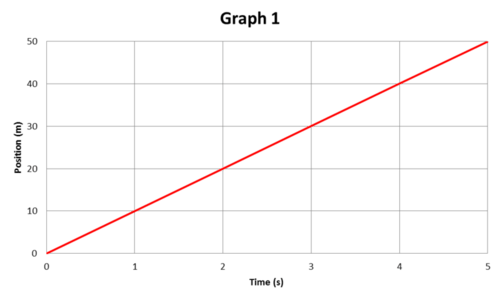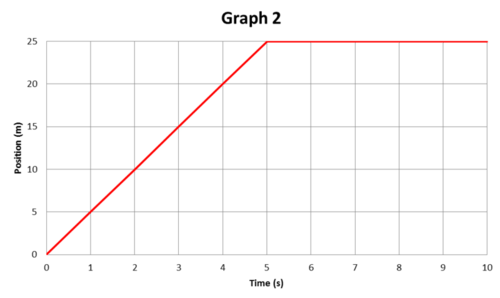2.8: Position vs. Time Graphs
- Page ID
- 4839

Drawing line graphs can help you understand motion. In this article, you’ll learn how to draw position-time graphs and how they show velocity.
Q: What’s missing from the graph being drawn in the picture above?
A: The x- and y-axes are missing.
Graphing Position and Time
The motion of an object can be represented by a position-time graph like Graph 1 in the Figure below. In this type of graph, the y-axis represents position relative to the starting point, and the x-axis represents time. A position-time graph shows how far an object has traveled from its starting position at any given time since it started moving.

Q: In the Figure above, what distance has the object traveled from the starting point by the time 5 seconds have elapsed?
A: The object has traveled a distance of 50 meters.
Slope Equals Velocity
In a position-time graph, the velocity of the moving object is represented by the slope, or steepness, of the graph line. If the graph line is horizontal, like the line after time = 5 seconds in Graph 2 in the Figure below, then the slope is zero and so is the velocity. The position of the object is not changing. The steeper the line is, the greater the slope of the line is and the faster the object’s motion is changing.

Calculating Average Velocity from a Position-Time Graph
It’s easy to calculate the average velocity of a moving object from a position-time graph. Average velocity equals the change in position (represented by Δd) divided by the corresponding change in time (represented by Δt):
velocity=Δd/Δt
For example, in Graph 2 in the Figure above, the average velocity between 0 seconds and 5 seconds is:
velocity=Δd/Δt=(25 m−0 m)/(5 s−0 s)=25m/5s=5 m/s
Watch this two-part video series for more position vs. time graph examples.
Use the following PLIX Interactive to make a position-time graph for a runner who changes speed during their run:
Interactive Element
Summary
- Motion can be represented by a position-time graph, which plots position relative to the starting point on the y-axis and time on the x-axis.
- The slope of a position-time graph represents velocity. The steeper the slope is, the faster the motion is changing.
- Average velocity can be calculated from a position-time graph as the change in position divided by the corresponding change in time.
Review
- Describe how to make a position-time graph.
- What is the slope of a line graph? What does the slope of a position-time graph represent?
- Can a line on a position-time graph have a negative slope, that is, can it slope downward from left to right? Why or why not?
- In Graph 1 in the Figure above, what is the object’s average velocity?
Additional Resources
Study Guide: Motion Study Guide
Real World Application: The Bullet Drop
PLIX: Play, Learn, Interact, eXplore: Irwin and Ruthie
Video:

